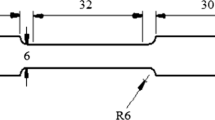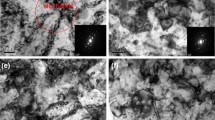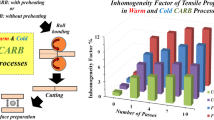Abstract
Sheets from commercial purity aluminium AA1050 and aluminium alloy AA6016 were processed by accumulative roll bonding to obtain an ultrafine-grained microstructure. The accumulative roll bonded samples showed a significant increase in specific strength paired with high ductility. Despite a strongly elongated grain structure, tensile testing of samples oriented 45° to the rolling direction revealed considerable improvement in elongation to failure compared to the samples oriented parallel to the rolling direction. From hydraulic bulge tests, it was observed that the accumulative roll bonded samples reached higher burst pressures and slightly lower equivalent strains in comparison to the as-received conventionally grain-sized samples. This behaviour reflects the extraordinary mechanical properties of the ultrafine-grained materials and indicates promising metal sheet formability.




Similar content being viewed by others
References
Horita Z (2005) Proceedings of the 3rd International Conference on nanomaterials by severe plastic deformation, Trans Tech Publications Ltd, 2005
Saito Y, Tsuji N, Utsunomiya H, Sakai T, Hong RG (1998) Scr Mater 39:1221. doi:https://doi.org/10.1016/S1359-6462(98)00302-9
Tsuji N, Saito Y, Lee S-H, Minamino Y (2003) Adv Eng Mater 5:338. doi:https://doi.org/10.1002/adem.200310077
Valiev RZ, Islamgaliev RK, Alexandrov IV (2000) Prog Mater Sci 45:103
Valiev RZ, Zehetbauer MJ, Estrin Y, Höppel HW, Ivanisenko Y, Hahn H et al (2007) Adv Eng Mater 9:527. doi:https://doi.org/10.1002/adem.200700078
Lapovok R, Mc Kenzie PWJ, Thomson PF, Semiatin SL (2007) Int J Mater Res 98:325
Höppel HW, May J, Göken M (2004) Adv Eng Mater 6(9):781. doi:https://doi.org/10.1002/adem.200306582
Topic I, Höppel HW, Göken M (2007) Int J Mater Res 98:4
Topic I, Höppel HW, Staud D, Merklein M, Geiger M, Goken M (submitted to) Adv Eng Mater
Skrotzki W, Hünsche I, Hüttenrauch J, Oertel CG, Brokmeier HG, Höppel HW, et al (2007) Accepted in Texture, Stress and Microstructure
Hannon A, Tiernan P (2008) J Mater Process Technol 198:1. doi:https://doi.org/10.1016/j.jmatprotec.2007.10.015
Acknowledgements
The authors thank the German Research Association (Deutsche Forschungsgemeinschaft DFG) for financial support within SFB 396, the Chair of Manufacturing Technology at the Friedrich-Alexander University Erlangen-Nürnberg, for the support and cooperation regarding bulge testing and W. Skrotzki at the Technical University of Dresden for conducting the texture measurements.
Author information
Authors and Affiliations
Corresponding author
Rights and permissions
About this article
Cite this article
Topic, I., Höppel, H.W. & Göken, M. Influence of rolling direction on strength and ductility of aluminium and aluminium alloys produced by accumulative roll bonding. J Mater Sci 43, 7320–7325 (2008). https://doi.org/10.1007/s10853-008-2754-3
Received:
Accepted:
Published:
Issue Date:
DOI: https://doi.org/10.1007/s10853-008-2754-3




